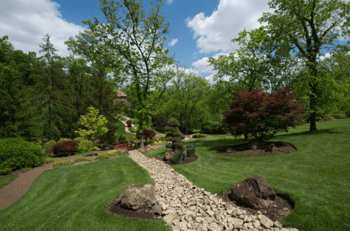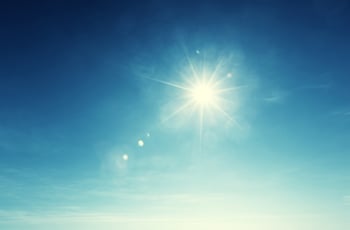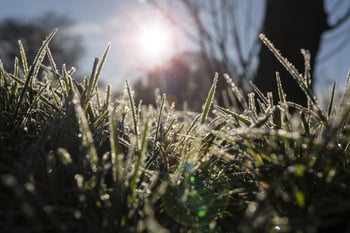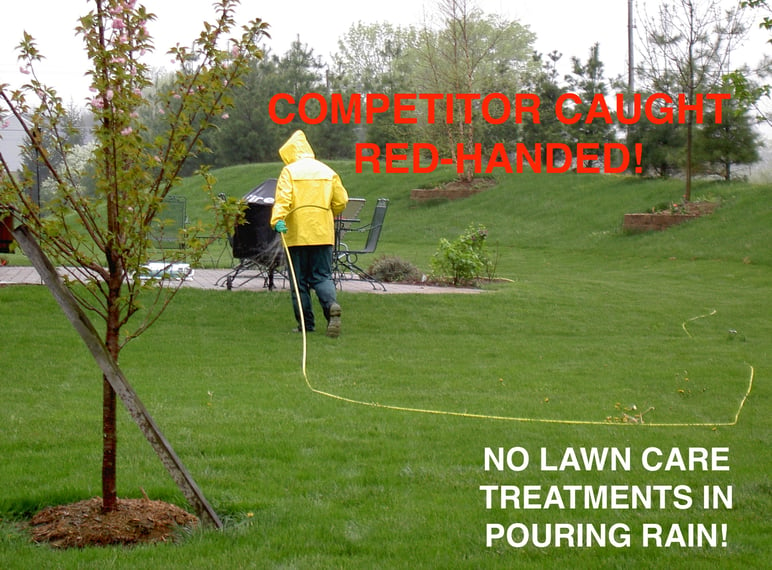 While it would be nice if the weather always offered the ideal conditions for your lawn to thrive - 60 degrees at night and 80 degrees during the day with a perfect two-inches of soft, steady rain each week - the truth is, weather sometimes throws a curveball. Whether it’s lawn care and rain, lawn care and hot weather, or lawn care during cold periods, dealing with Mother Nature is part of the job.
While it would be nice if the weather always offered the ideal conditions for your lawn to thrive - 60 degrees at night and 80 degrees during the day with a perfect two-inches of soft, steady rain each week - the truth is, weather sometimes throws a curveball. Whether it’s lawn care and rain, lawn care and hot weather, or lawn care during cold periods, dealing with Mother Nature is part of the job.
While the weather certainly plays a role in your lawn care results, it can be difficult to determine to what degree. You may even wonder, from time-to-time, if the weather is a primary culprit of stress on your lawn or an excuse your company is using to cover for mediocre products and service.
Our hope is that by sharing with you some common impacts weather may have on your lawn care results, you will be able to determine the difference between an excuse and a legitimate reason.
Lawn Care and Rain
Don’t panic if it’s raining after you’ve had a lawn care treatment. Contrary to what some homeowners believe about rainwater washing product away, the truth is that rain helps activate granular material in the soil. Even if it pours, very little product (if any) will be lost to runoff since the tiny granules dissolve before they can be washed away. Liquid weed control, on the other hand, may need a few hours to become rainfast. After that, rainfall is not a problem.
Although a good company may not be able to predict the rain, they will still revisit for free should your lawn not respond to treatment due to rain - or any other reason for that matter. If your company is doing this - taking extra time out of their schedule to troubleshoot problems caused by weather- then you can feel confident they aren’t just using it as an excuse.
Lawn care in wet weather can definitely still work. Bear in mind, though, that excessive rainfall over a long period of time can cause some crabgrass breakthrough. If it’s an excessively rainy spring and summer, pre-emergent product may not perform as well as it does in normal conditions.
A good company, however, will also be utilizing post-emergent crabgrass control which will take care of that breakthrough. A company that offers a comprehensive program is a great defense against weather.
It’s also worth noting that lots of rain and continuous humidity can contribute to more turfgrass disease than usual. Brown Patch and Red Thread are two common lawn diseases that we see in our region as a result of too much moisture. Both of these diseases are caused by fungi (though two different types), which grow when conditions are hot and wet. While disease can be a hassle, if you have well-trained lawn care technicians keeping a regular eye on your lawn will spot it early.
Lawn Care During Times of Drought
While rain can cause problems, the truth is that a lack of rain is often the bigger concern. Drought can actually make it challenging for weed control products to work well as the weeds need to be actively growing in order for the product to do its job. As the weeds grow and nutrients are translocated down to the roots, so is the weed control product that will ultimately stop weeds from growing.
During times of drought, any lawn care stresses, such as that from chinch bugs or other surface feeding insects, also become more noticeable. The reason it’s more noticeable is because vigorously growing turf often masks symptoms. Drought, on the other hand, makes damage accelerate faster. Again, having a lawn care program in place that is focused on prevention will help avoid many of these concerns.
Lawn Care and Hot Weather
 Heat can wreak havoc on your lawn when it becomes excessive and ongoing. When the weather is hot, grass can wilt and it becomes easier for weeds to grow in thin areas. Weeds don’t require ideal growing conditions to thrive like turf.
Heat can wreak havoc on your lawn when it becomes excessive and ongoing. When the weather is hot, grass can wilt and it becomes easier for weeds to grow in thin areas. Weeds don’t require ideal growing conditions to thrive like turf.
Hot summers can also lead to more surface insect issues such as chinch bugs. The combination of heat and moisture can also create a breeding ground for disease. Typically, when nights are consistently above 70 degrees and days are consistently above 85, the scene may be set for disease to creep in.
Excessive periods of heat and drought together can also cause general thinning of lawns or, in a worst case scenario, areas that won't recover. Turf typically recovers from a few weeks of drought, but when lawns go with hot, dry conditions for 4 weeks or more it can mean big trouble.
Though they can’t promise your lawn will look great during extreme weather, a good lawn care company can help get you through a drought. For one, they will help keep an ongoing eye on your property and help you know when extra watering may be required. And though your lawn may show some signs of stress, you can also feel good knowing that it will recover if you’ve been using a lawn care company focused on soil health. The microbiology that has been going into the soil will go a long way in helping it bounce back.
Lawn Care and Cold Weather
Fall is the best time to control some of the most difficult-to-control weeds, and fertilizers throughout fall and into early winter are great materials to stimulate root growth. However, when conditions get very cold later in December, some treatments like weed control aren't as effective.
During the colder months, cold temperatures slow plant growth which means weed control materials aren't as easily moved throughout plants.
This is why there is a delay in lawn care treatments from mid-December to late February, and also why we try to get them wrapped up by early December with the last fertilizer application (which promotes root growth over the winter and earlier spring green-up, next season).
While pests and diseases aren’t a big concern during the cold months, there is still the slight possibility of snow mold occurring on lawns. Long periods of snow cover can lead to the growth of some snow mold, but most times lawns recover. Keeping your lawn clear of debris prior to the first snowfall can help prevent snow mold growth as it tends to thrive under leaves and sticks where some heat is generated underneath the snow. In order to lessen the chances of snow mold damage, mow your lawn until it stops growing in late fall, and mow to around 2.5 inches. This will prevent excessively long grass blades that can become more easily matted down.
It’s also worth mentioning that walking on frosty lawns can cause some cosmetic damage as it will leave marks that will remain on the broken grass blades until they grow out in the spring.
Accounting for Weather
There is no lawn care program out there that can claim to go head-to-head with Mother Nature and win. Unfortunately a lot of people assume that by paying for a professional lawn care service, they should never have a problem again.
In reality, Mother Nature has the ability to humble even the greatest lawn care companies. We can do everything the right way but at the end of the day, Mother Nature is going to impose her will on the outcome and that is out of our control.
Still, that’s not to say that your lawn can’t handle weather challenges. If you’ve found a company that is doing things the right way and focusing on soil health, then your lawn will come through even the toughest times. If you’re giving your lawn what it needs, you’re ultimately helping prepare it to rebound from rough weather. Though it may not look its absolute best during a drought or after an excessive amount of rainfall, your lawn will be the first on the block to bounce back from a period of extreme stress if you’ve been working with a great lawn care company.
While we don’t make any claims that we can go up against weather and win, we do make a point to account for weather changes. For example, while some companies will apply weed control whenever works for them, we base it on temperature so that it will be as effective as possible. We always focus on doing what is best for our customers and their lawns - not what is best for our revenue stream.

Sometimes that even means our employees can’t work for a day. While other companies will be out there applying product on top of snow or amidst pouring rain, we’d rather put things on hold to ensure you’re getting effective results. If a company is applying product during pouring rain and then tries to tell you the weather was out of their control, that is an abuse of the weather excuse. While we can’t prevent a downpour, we can hold off a day if it’s in the best interest of our clients.
We know that weather is frustrating - it certainly is for us - and that’s also why we go above and beyond to communicate how weather may affect your lawn care program. We are always keeping in touch with our clients and keeping them informed, and that includes weather concerns.
In addition, we also want to give our clients tools that will help their lawn succeed so we may encourage you to keep up with watering your lawn if we’re in a period of drought. Mother Nature may not always give us exactly what’s needed for your lawn to thrive, but we can still do our best to work with what we were given. At Oasis Turf & Tree, we work with our clients every step of the way and that includes getting them through weather challenges.
Contact us or give us a call at 513-697-9090 if you’d like more information on how weather might be affecting your lawn care, or how we can help with your Cincinnati, Dayton, OH or Northern Kentucky property.

